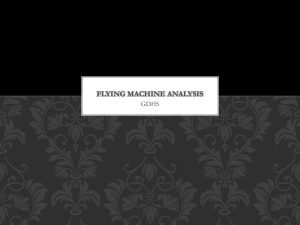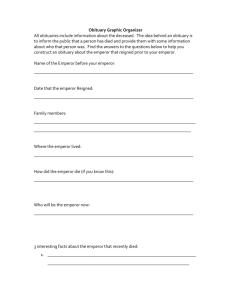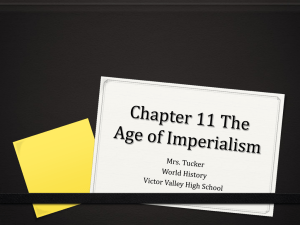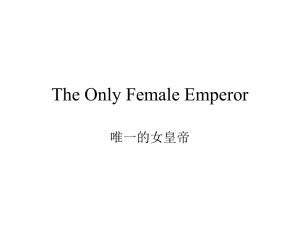The Flying Machine: Literary Analysis by Ray Bradbury
advertisement
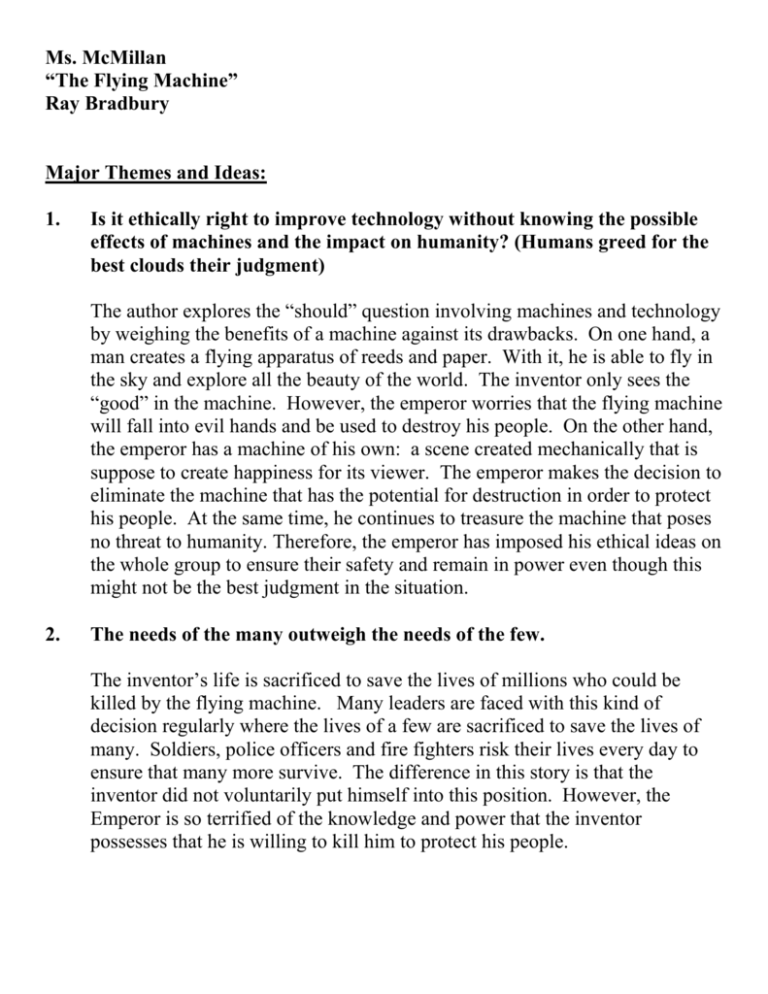
Ms. McMillan “The Flying Machine” Ray Bradbury Major Themes and Ideas: 1. Is it ethically right to improve technology without knowing the possible effects of machines and the impact on humanity? (Humans greed for the best clouds their judgment) The author explores the “should” question involving machines and technology by weighing the benefits of a machine against its drawbacks. On one hand, a man creates a flying apparatus of reeds and paper. With it, he is able to fly in the sky and explore all the beauty of the world. The inventor only sees the “good” in the machine. However, the emperor worries that the flying machine will fall into evil hands and be used to destroy his people. On the other hand, the emperor has a machine of his own: a scene created mechanically that is suppose to create happiness for its viewer. The emperor makes the decision to eliminate the machine that has the potential for destruction in order to protect his people. At the same time, he continues to treasure the machine that poses no threat to humanity. Therefore, the emperor has imposed his ethical ideas on the whole group to ensure their safety and remain in power even though this might not be the best judgment in the situation. 2. The needs of the many outweigh the needs of the few. The inventor’s life is sacrificed to save the lives of millions who could be killed by the flying machine. Many leaders are faced with this kind of decision regularly where the lives of a few are sacrificed to save the lives of many. Soldiers, police officers and fire fighters risk their lives every day to ensure that many more survive. The difference in this story is that the inventor did not voluntarily put himself into this position. However, the Emperor is so terrified of the knowledge and power that the inventor possesses that he is willing to kill him to protect his people. Setting: The time period for this story is 400 A.D. Because the Julian calendar is being referred to here, one could conclude that it is February 1st. However, it is also possible that while the narrator placed the 400 A.D. into the story for the audience’s reference, the time could also be based on the Chinese Lunar calendar, making it later than February 1st. The land is readying itself towards the harvest, but because we don’t know what crop is being referred to, it could be spring or summer; this is significant because it suggests rebirth and new beginnings. The place is the emperor’s palace in the countryside with the Great Wall of China nearby. The atmosphere of the story is peaceful, serene and tranquil. It juxtaposes the natural world of the setting to the mechanical world of the inventor. The mood becomes tense at times as people are executed. Major Characters: 1. The Emperor of China (Yuan) in 400 A.D. He is an old man who likes to drink tea and has a fan. There is no other physical description in this story of him; probably so as to keep focus on the setting and the dialogue between characters. He respects and enjoys the simple things in life. He is thoughtful and does not react to a situation before careful reflection. He is also fair when he spares the lives of the servants. The Emperor embodies the ethical dilemmas that a society must face when it questions whether technology should be introduced or enhanced. The Emperor sees the advantages and drawbacks of the machine but makes the decision to destroy it because of its potential threat to take lives. This attitude can be compared to contemporary scientists who often create things without ethics (for example, stem cell research, nuclear technology and cloning). 2. The Inventor The inventor is a man with much talent, but he only chooses to see how his invention will help him to enjoy life better than the potential for danger that his creation could trigger. He respects the emperor. He knows enough to ask for mercy from the emperor but he fails to see the harm his invention could cause. Therefore, he is narrow-minded and looks at his creation with tunnelvision. There are no physical details of the inventor provided in the story because this puts more emphasis on the invention itself and not the character. He is also not described because then the reader can identify more with the character since they can see themselves as that character. 3. The Servant The servant is a loyal person to the throne. He is quick to report his findings to the emperor and he is patient and respectful towards the emperor’s hesitation and reflection regarding the machine. The servant is also smart enough to consider his self-preservation by promising never to speak of this creation again. Similarly, there is no physical description of him because he is a secondary character. Juxtaposition is created between the servant and the emperor highlighting how cruel the emperor is. Plot: 1. The incident that gets the plot rolling is the servant informing the emperor of his discovered miracle. The reader wonders what miracle could have occurred and continues to read on. 2. An interesting development is that the emperor reacts with horror instead of wonder when he sees the “miracle” for himself. It is unexpected that a person would have enough foresight to see the evils of such a wondrous creation. Another interesting development is the juxtaposition between the emperor’s music box and the flying machine. The emperor demonstrates that one should be cautious of an invention that creates such joy as the flying machine. It is also interesting that the Emperor is one of the leaders who fostered the development of the Great Wall. It must have been a decision made after countless threats and events involving death and destruction. It is easy to see, then, how the emperor is so sceptical when it comes to this flying machine. 3. The climax of the story is the execution of the inventor. At this point, the major problem/conflict is resolved. A second climax could be when the life of the servant is spared because one wonders how far the emperor will go to ensure that the threat of the flying machine is erased from his land. 4. The denouement is the emperor returning to the music box. It is probable that the emperor closes his eyes and imagines himself flying in the very machine he had destroyed. It is a powerful ending as it closes with the reader understanding that this emperor had much control to avoid possessing the flying machine himself. Undoubtedly, the emperor would have appreciated its value and the beauty around him; however, the threat was too great. Other world leaders might determine that they had enough control to possess the machine and use it for their amusement and to destroy others, but this leader is able to practice enough restraint to protect his world and to use his imagination to explore the heavens. Style: Bradbury crafts this story using many literary devices. There are three that stand out as being exemplary. To begin, he uses Imagery: so that the five senses are activated to bring the reader into this serene and perfect world he has created. By referring to the taste of the tea, the air on one’s face, the sounds of the birds, the scenery and the smell of the warm air, the audience is right there experiencing the story and thus understands the mood as calm. Similes: Bradbury also employs a number of similes to make comparisons. Bradbury writes, “a dragon of paper and bamboo coloured like the sun and the grass” () The flying machine is described in a positive and beautiful way that encourages the reader to think that it is, in fact, not a harmful machine. Except that dragons are depicted as dangerous beasts that could cause damage to people and their society, therefore; a juxtaposition is created within the simile that highlights the beauty and danger of the machine. Metaphor: he utilizes is the comparison of the flying machine to a dragon in a land of ancient dragons to bring an impression of culture and uniqueness to the invention. Which lends to a specific voice in the author’s writing by creating a scene that is stereotypical of Ancient China. Finally, he is a master of sound effects. The phrase “splendid snake of stones” to describe the Great Wall represents both alliteration and consonance. The audience can easily hear the hissing of the snake that represents the huge wall sprawling across the land. This literary device is used to emphasize the importance of the wall to the Emperor and its significance to the protection of his kingdom. Describing the wall as a snake suggests that it is dangerous and not to be messed with. By using all these devices so effectively, Bradbury demonstrates a distinguished and unique voice that sets him apart from other authors. Often, his style is more figurative than literal, so that the audience must pay careful attention and reflect on his ideas. The diction is fairly straight-forward so that the audience can understand the ideas and concepts being presented. He uses simple language in his dialogue and injects respect into the words of the servant and inventor as well as an air of confidence and detachment in the words of the emperor which highlights their character traits and heightens the tone of the story so that you feel as though you are reading a fable or morality-based tale (like a fortune cookie). CONNECTIONS Text to Self: I faced a dilemma recently when I made the decision to upgrade my phone. There was nothing wrong with my phone but it wasn’t the shiny new phone that other people had with the touch screen and the fancy connections to the internet. I tried to justify getting this new phone over keeping the old one. I didn’t want to be lured in by the new technology and status that this phone would offer me. At the same time, I didn’t want to pass up a great deal and opportunity to explore this new level of technology. In the end, I traded up with some regret. There is a huge learning curve with owning this new phone, and I know that I have not used it to its full potential. I feel a lot like the emperor who is more amused by a machine than one who is more impressed with its possibilities. I also recognize that there are some “evils” attached to this phone which will change me as a person as I become better at texting and less available to be face-to-face with a person. This new phone makes it impossible for me to be out-of-touch and I hope it’s something that I don’t regret down the line. Text-to-text: Science fiction movies including The Terminator series remind us about our delicate relationship with machines. Since the industrial revolution, we have used machines to make work easier and to make life more convenient. However, we still need to question how far we should be going with machines. Even something as innocent-sounding as a “flying machine” can have evil consequences, and the Terminator reminds us that machines could one day turn on and enslave mankind. Text to world: The story of the Flying Machine relates to many events that have happened in the world. For instance, the creation of the life support machine is a remarkable device that has saved thousands of people over the years, however, the question of whether we should keep people alive because we can or should we allow people to die when they can no longer sustain themselves is thrown into question. There have been many issues in the news where families have chosen to keep a family member alive when there is no possibility of their survival without the machine’s aid. Some family members argue that it is better to let the family member die than to keep them alive for the good of their family relationships. This connects very well with the story since the impact of technology is questioned by the reader when the emperor kills the flyer.

